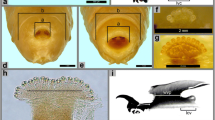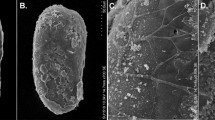Abstract
Examination of the puparia of the housefly, Musca domestica L. and blowfly Chrysomya megacephala (F.), through scanning electron microscopy (SEM), revealed many differences in the profile of their morphology. Special attention was focused on puparial characteristics used to differentiate between the two fly species studied, and between other forensically important flies. Results of this study indicate that the housefly puparia are almost evenly rounded at both ends and the anterior spiracle bears six papillae. A pair of pupal respiratory horns is found laterally before the posterior boundary of the first abdominal segment, bearing numerous papillae that have a longitudinal opening along the oval convex base. The peritreme of each posterior spiracle forms a crude forward or reverse D-shape, encircling three sinuous slits. The blowfly pupariums anterior spiracle contains 8–12 papillae. The pupal respiratory horns protrude slightly and in some specimens a group of ~38 globules on the bubble-like membrane may be observed. Each of the posterior spiracles is more or less an oval- shaped peritreme, encircling three straight spiracular slits. The anatomical features presented herein allow for the differentiation of puparia of the two fly species studied and could prove useful in future forensic entomological assessments.




Similar content being viewed by others
References
Amorim JA, Ribeiro OB (2001) Distinction among the puparia of three blowfly species (Diptera: Calliphoridae) frequently found on unburied corpses. Mem Inst Oswaldo Cruz 96:781–784
Benecke M (1998) Six forensic entomology cases: description and commentary. J Forensic Sci 43:797–805
Bourel B, Fleurisse L, Hedouin V, Cailliez JC, Creusy C, Gosset D, Goff ML (2001) Immunohistochemical contribution to the study of morphine metabolism in Calliphoridae larvae and implications in forensic entomotoxicology. J Forensic Sci 46:596–599
Byrd JH, Castner JL (2001) Insects of forensic importance. In: Byrd JH, Castner JL (eds) Forensic entomology: the utility of arthropods in legal investigations. CRC Press, Florida, pp 43–79
Erzinclioglu Z (2000) Maggots, murder and men. St. Martin’s Press, New York
Gordon G (2001) A dictionary of entomology. CABI Publishing, UK
Greenberg B, Kunich JC (2002) Entomology and the law. Flies as forensic indicators. Cambridge University Press, Cambridge
Kitching RL (1976) The immature stages of the Old-World screw-worm fly, Chrysomya bezziana Villenuve, with comparative notes on other Australasian species of Chrysomya (Diptera, Calliphoridae). Bull Entomol Res 66:195–203
Liu D, Greenberg B (1989) Immature stage of some flies of forensic importance. Ann Entomol Soc Am 82:80–93
Lord WD (1990) Case histories of the use of insects in investigations. In: Catts EP, Haskell NH (eds) Entomology and death: a procedural guide. Joyce’s Print Shop, Clemson, pp 9–37
Miller ML, Lord WD, Goff ML, Donnelly B, McDonough ET, Alexis JC (1994) Isolation of amitryptiline and nortryptiline from fly puparia (Phoridae) and beetle exuviae (Dermestidae) associated with mummified remains. J Forensic Sci 39:1305–1313
Skidmore P (1985) The biology of the Muscidae of the world. Junk Publishers, The Netherlands
Smith KGV (1986) A manual of forensic entomology. Cornell University Press, NY
Sukontason K, Sukontason KL, Ngern-klun R, Sripakdee D, Piangjai S (2004) Differentiation of the third instar of forensically important fly species in Thailand. Ann Entomol Soc Am 97:1069–1075
Acknowledgements
We thank Noppawan Boonchu and Duanghatai Sripakdee for technical assistance. This work received support from the Thailand Research Fund (RGJ; PHD/0059/2546). We thank Chiang Mai University for funding the reprint cost.
Author information
Authors and Affiliations
Corresponding author
Rights and permissions
About this article
Cite this article
Siriwattanarungsee, S., Sukontason, K.L., Kuntalue, B. et al. Morphology of the puparia of the housefly, Musca domestica (Diptera: Muscidae) and blowfly, Chrysomya megacephala (Diptera: Calliphoridae). Parasitol Res 96, 166–170 (2005). https://doi.org/10.1007/s00436-005-1343-5
Received:
Accepted:
Published:
Issue Date:
DOI: https://doi.org/10.1007/s00436-005-1343-5




